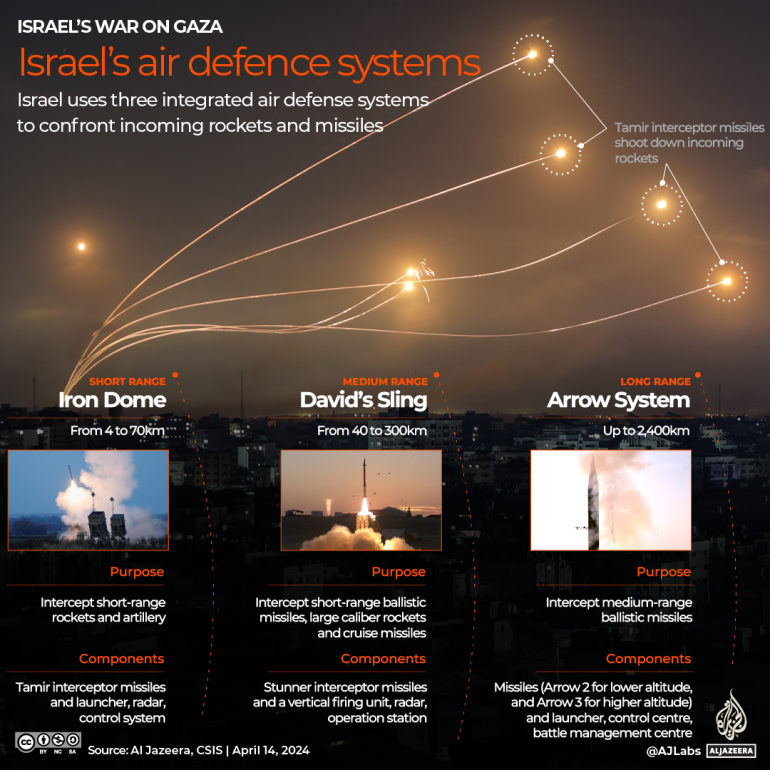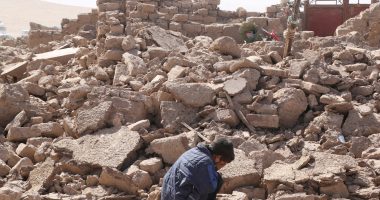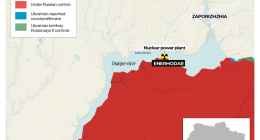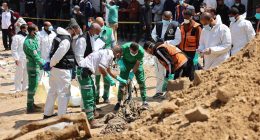Tehran, Iran – Iran’s use of hundreds of drones and missiles to directly target Israel on Saturday night and Sunday morning set a number of major political and military precedents.
It was the single largest drone attack ever carried out by any country, and it was the first time Iran directly attacked Israel after almost a half-century of being archenemies.
Here’s a look at what political, military and economic considerations Tehran might have factored in while deciding on the attack that has amplified fears of a larger regional war and that could also affect the direction of Israel’s war on Gaza.
The politics
The Islamic Revolutionary Guard Corps (IRGC) dubbed the operation “True Promise” to show that top leaders in Tehran, including Supreme Leader Ayatollah Ali Khamenei, intend to make good on their vows of “punishment” for attacks by Israel and others.
The attack was a direct retaliation for an Israeli strike on the Iranian consulate in Damascus on April 1 that killed seven IRGC members, including two generals in charge of leading operations in Syria and Lebanon, along with six other people.
It was mainly aimed at strengthening Iran’s deterrence which critics said had been compromised after increasingly confrontational policies and military strikes by the United States and its allies across the region, especially following the January 2020 assassination of top general Qassem Soleimani in Iraq.
Iranian officials also appeared to have exercised a degree of “strategic patience” after the late December assassination of another top IRGC commander in Syria, Razi Mousavi, in an Israeli air raid amid the fallout of the war on Gaza.
Inaction, lower-grade strikes, or being content with military action through the “axis of resistance” of aligned groups across the region would in this vein be viewed as too costly for Iran both locally and abroad.
That is true even as Tehran recognises that Israel and the embattled government of Prime Minister Benjamin Netanyahu may see benefits in escalating tensions across the region and forcing the US military into taking more action against Iran.
On the other hand, the unprecedented Iranian attacks may have briefly shifted the world’s attention from the deaths of tens of thousands of women and children in the Gaza Strip, but they could translate into soft power gains for Iran in the Muslim world in the long run, when compared with other regional powers.
Saudi Arabia has not ruled out normalising relations with Israel despite the carnage in Gaza, and Turkey only started limiting some exports to Israel earlier this week after the Israeli government refused to allow it to airdrop aid over the besieged enclave, where infants are dying of starvation. Both Saudi Arabia and Turkey have, however, been deeply — and vocally — critical of Israel’s war on Gaza.
Iran would also have plausible arguments at the United Nations Security Council since attacks on diplomatic missions signal a violation of the Vienna Convention, and since Article 51 of the UN Charter enshrines the “inherent right” of self-defence, something Israel has been heavily leaning on since the start of the Gaza war.
A list of military firsts for Iran
There is no official confirmation from Iran about exactly how many drones or ballistic and cruise missiles it used to attack Israel, but the Israeli military said more than 300 were launched.
Iranian drones have been making international headlines for the past few years, especially following Russia’s invasion of Ukraine more than two years ago. Ukrainian officials say the Iranian-designed Shahed drones of the Russian military continue to rain down over their territory.
Shahed-136 kamikaze drones that carry a relatively small warhead weighing some 50kg (110 pounds) were used in the attack on Israel, Iranian state television said on Sunday.
Telegram channels affiliated with the IRGC said the Shahed-238, which is powered by a turbojet rather than the propeller on the 136 model, was also used in the attack. The 238 model sacrifices some manoeuvrability for significantly higher speeds that are believed to reach as high as 600kmph (372mph).
Iran has long been known to possess the largest and most varied missile arsenal in the Middle East, but this was by far the largest test of its capabilities.
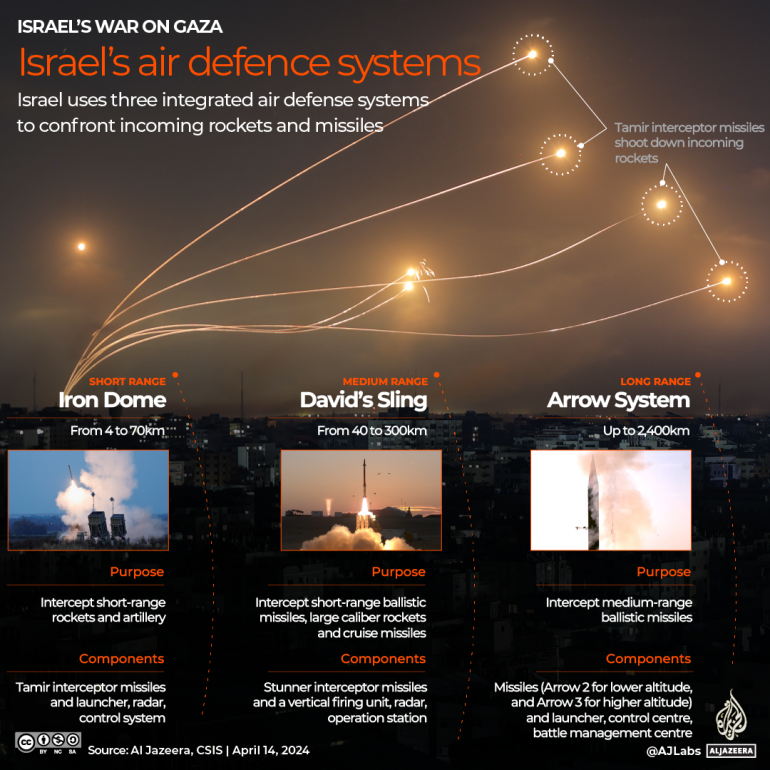
State television said the Emad long-range ballistic missile and the Paveh cruise missile were used to attack Israel.
In February, in large-scale military exercises that included simulating an attack on the Palmachim airbase in Israel, the IRGC used Emad missiles and launched the Dezful ballistic missile from a warship.
Iran also possesses Fattah, a hypersonic ballistic missile that could theoretically arrive in Israel in as little as seven minutes, along with a cruise missile variant of the same family. There was no indication the missiles were used in the early Sunday attacks.
Either way, in multilayered attacks over several hours, Iran has just managed to conduct its largest-ever drone and missile strikes that covered some of their longest distances in a real military operation.
“The operation achieved a level of success that exceeded our expectations,” said IRGC commander-in-chief Hossein Salami, adding that the projectiles only targeted military sites, including the Nevatim airbase in the Negev desert that was allegedly used to launch the Israeli strikes on the Iranian consulate in Syria.
What are the economic effects?
The effect of the historic attacks on the already-troubled Iranian economy was likely lower than the weight of political and military dimensions on the list of considerations for Iranian leaders as they planned the offensive in almost two weeks since the consulate attack.
But as expected, there was an immediate reaction in local markets, with foreign currencies climbing amid rising anxieties over prospects of the conflict further sliding into a regional war.
The rial, Iran’s falling national currency, dropped to a new all-time low of about 670,000 per US dollar on Sunday before regaining some ground.
The semiofficial Tasnim news website reported on Sunday that very few currency and gold deals are taking place in Tehran and other markets as an atmosphere of caution is dominant.
The Tehran prosecutor’s office announced on Sunday that it opened a case against an unnamed journalist and the Jahan-e Sanat newspaper they worked for due to “disturbing the society’s psychological security and disturbing the economic atmosphere of the country”.
Read More: World News | Entertainment News | Celeb News
Aljazera

